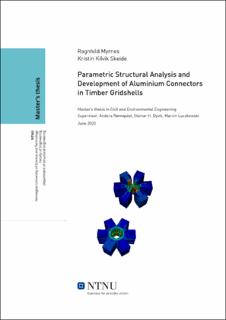| dc.contributor.advisor | Rønnquist, Nils Erik Anders | |
| dc.contributor.advisor | Dyvik, Steinar Hillersøy | |
| dc.contributor.advisor | Luczkowski, Marcin | |
| dc.contributor.author | Skeide, Kristin Kilvik | |
| dc.contributor.author | Myrnes, Ragnhild | |
| dc.date.accessioned | 2021-09-21T16:10:39Z | |
| dc.date.available | 2021-09-21T16:10:39Z | |
| dc.date.issued | 2020 | |
| dc.identifier | no.ntnu:inspera:56731605:1786379 | |
| dc.identifier.uri | https://hdl.handle.net/11250/2780010 | |
| dc.description.abstract | Gitterskallkonstruksjoner har tradisjonelt blitt bygd opp av rette stålelementer, sveiset eller boltet til stålforbindere. På grunn av miljøaspekter, utvikling av trelastprodukter, økt fokus på tre som byggemateriale både med hensyn til estetikk og materialegenskaper, bygges flere gitterskall nå i tre. Design av forbindere i gitterskall kan være komplisert på grunn av lastforholdene og omfattende geometrier. Med bakgrunn i at aluminium er et resirkulerbart materiale, har lav tetthet og er lettere å forme sammenlignet med stål, undersøkes muligheten for å utvikle forbindere i aluminium som en erstatning til forbindere i stål.
Elementanalyser av to gitterskallforbindere i aluminium er presentert. Den ene er “Glued Finger” (GF)-forbinderen, hvor alt materialet møtes i senteret. Den andre er “Split Ring” (SR)-forbinderen, hvor alt materialet er flyttet ut fra senteret. To hovedutfordringer med designet er identifisert og dimensjonert; kjernedelen og tre-til-metall-delen. For å gjøre dimensjoneringsprosessen av gitterskallforbindere mer effektiv, har elementanalyser blitt etterforsket i et parametrisk miljø. Tilpassede komponenter har med suksess blitt utviklet i programmene Rhino/Grasshopper, for å analysere den konstruksjonsmessige oppførselen til forbindere parametrisk. Komponentene muliggjør at designeren kan lage parametriske elementmodeller i 3D i Rhino/Grasshopper, og genererer input-filen (INP) som kan importeres som en modell og deretter sendes inn for analyse direkte i Abaqus.
Fra resultatene i den parametriske konstruksjonsanalysen ble det konkludert med at SR-forbinderen har det beste designet med tanke på volumeffektivitet og dermed også kostnadseffektivitet. Ved vurdering av om forbinderene er utsatt for knekking og hvordan de takler eksentriske laster, ser SR-forbinderen ut til å være et bedre design, på grunn av dens høye bøyestivhet om begge akser. For å forbedre opptredenen til GF-forbinderen i forhold til eksentriske laster og knekking, er det foreslått å legge til plater rettvinklet på midten av de indre platene. Derimot er rotasjonsstivheten til GF- forbinderen funnet å være rundt dobbelt så høy som rotasjonsstivheten til SR-forbinderen. Videre er det argumentert for at GF-forbinderen ser ut til å ha det mest praktiske designet ved montering av konstruksjonen på byggeplass, siden den består av færre deler som skal binde sammen treelementene. | |
| dc.description.abstract | Gridshell structures have traditionally been constructed with steel members welded together or bolted to steel connectors. Due to matters such as environmental aspects, developments of timber products and an increased focus on timber as a building material, both regarding aesthetics and material qualities, more gridshells are now being constructed with timber products. The design of the connections in gridshells can be complicated due to loading conditions and comprehensive geometries. This thesis investigates the possibility of developing aluminium connectors as a substitute to steel connectors, since aluminium is recyclable, has low density and is easier to form compared to steel.
Finite element analyses of two gridshell connectors in aluminium are presented. These are the “Glued Finger” (GF) connector, where the material meets in the centre, and the “Split Ring” (SR) connector, where the material is placed around the centre. Two main design challenges have been identified and checked structurally: the core part, and the timber-to-metal part. To make the design process of gridshell connectors more effective, finite element analyses (FEA) in a parametric environment have been explored. Custom components in the Rhino/Grasshopper software have successfully been developed to analyse the structural behaviour of connectors parametrically. The components enable the designer to make a parametric finite element 3D model in Rhino/Grasshopper, and scripts the input file (INP), which can be directly imported as a model to be submitted for analysis in Abaqus.
From the results in the parametric structural analysis, it was concluded that the SR connector is the best design regarding volume efficiency and thus also cost efficiency. When assessing whether the connectors are susceptible to buckling and how they handle eccentric loads, the SR connector seems to be the better design due to its high bending stiffness about both axes. To improve the performance of the GF connector regarding eccentric loads and buckling, it is proposed to add plates perpendicular to the middle of its inner plates. Nevertheless, the rotational stiffness of the GF joints is found to be about twice as high as the rotational stiffness of the SR joints. Furthermore, the GF connector is argued to be the most practical design when assembling the structure at building site, as it consists of less parts that connects the timber members together. | |
| dc.language | | |
| dc.publisher | NTNU | |
| dc.title | Parametric Structural Analysis and Development of Aluminium Connectors in Timber Gridshells | |
| dc.type | Master thesis | |
